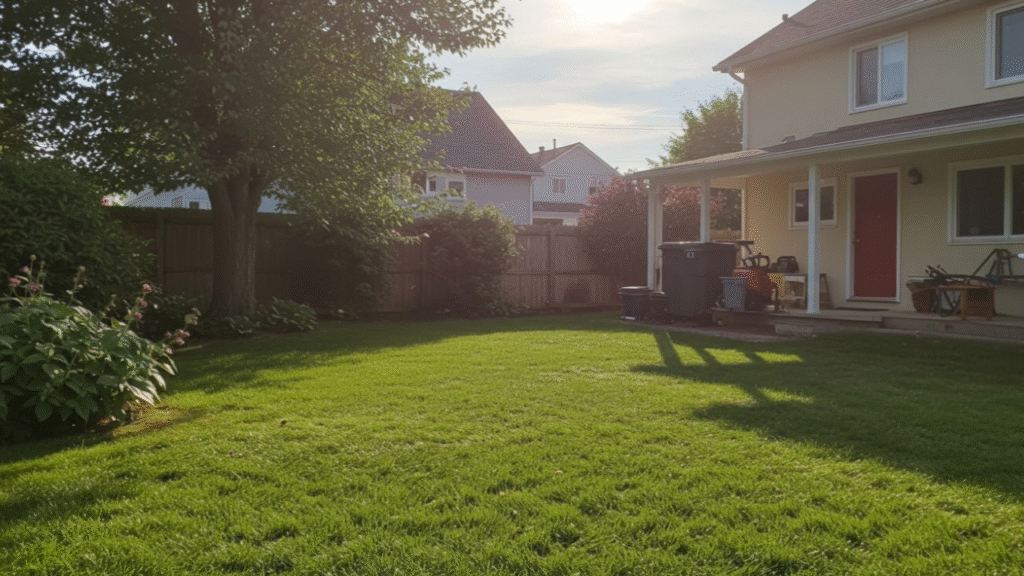
The moment you step outside to enjoy your backyard oasis, you discover it: a persistent brown patch on the lawn, or pool water that has suddenly turned a worrying shade of green. Backyard ownership means confronting these inevitable issues. The key to staying confident and avoiding expensive professional call-outs is knowing the fast, effective fixes for the most common pool and lawn problems. This guide provides an actionable, systematic approach to diagnosing and solving problems quickly, ensuring your outdoor space remains a source of relaxation, not stress.
Pool Problems: Rapid Solutions for Clarity and Health
A healthy pool is all about chemistry, circulation, and vigilance. When problems arise, they usually stem from a breakdown in one of these three areas.
Cloudy or Green Water
Green water is typically caused by algae growth, while cloudy water suggests poor filtration or improper $\text{pH}$ balance.
The Quick Fix: First, clean your filters and ensure the pump is running for at least 10–12 hours a day. Next, manually brush the entire pool surface (walls, floor, and steps) to loosen algae. Shock the pool with a high dose of granular chlorine, following package instructions carefully. Allow the pump to run overnight to circulate the shock treatment. The next morning, the water should be cloudy blue/gray, indicating the algae is dead.
The Cleanup: Use an intelligent, robotic cordless pool vacuum to systematically vacuum the dead algae and debris that has settled on the floor. Because these units use their own filtration bags, they prevent the dead particles from clogging your main filter and returning to the pool. Ensure your pool skimmer baskets are emptied immediately after shocking and frequently during the cleanup process to maintain optimal water flow and efficiency.
Low Water Level or Leaks
A noticeable drop in water level that can’t be explained by heavy use or high evaporation suggests a leak.
The Quick Fix: Perform the bucket test. Place a bucket of pool water (with the water level matching the pool) on a step. Mark the water levels both inside and outside the bucket. After 24 hours, if the pool level has dropped significantly more than the bucket level, you likely have a leak.
The Next Steps: Inspect the visible components—plumbing behind the pump, filter, and heater. Tighten any loose connections. If the leak persists, it may be in the underground pipes or the pool structure itself, requiring professional leak detection, but checking visible plumbing first saves time and money.
Lawn Issues: Diagnosing and Treating Turf Troubles
Lawn problems often look similar, but the solutions for disease, pests, and nutrient deficiencies are entirely different. Correct diagnosis is critical.
Brown or Dry Patches
If your lawn has uniform brown patches, the issue is likely a combination of poor water delivery and high heat stress.
The Quick Fix: Check your irrigation system. Manually inspect all sprinkler heads in the affected area. A blocked or broken head can leave a specific area dehydrated, causing it to die off. Run the system manually to confirm coverage. If coverage is fine, the area may be compacted. Use a pitchfork to create small aeration holes across the patch to allow water and air to penetrate the soil. Then, perform a deep, soaking water cycle.
The Ongoing Solution: Program your irrigation system to water deeply and infrequently (e.g., three times per week for 30 minutes, rather than seven times a week for 10 minutes). This encourages deep root growth, making the grass more resilient to future drought stress.
Yellowing Grass or Visible Spots
Yellowing (chlorosis) suggests a nutrient deficiency, usually iron or nitrogen. Circular spots could indicate fungus.
The Quick Fix for Yellowing: Apply a liquid chelated iron supplement. Iron gives the grass its deep green color and is easily absorbed via foliar spray. For overall pale grass, apply a nitrogen-rich, slow-release fertilizer.
The Quick Fix for Fungus: Look for circular patches that often have a dark ring. Fungal diseases thrive in humid conditions and can be spread by mowing wet grass. Immediately reduce watering and ensure the lawn is mowed high and only when dry. Apply a systemic fungicide to the affected areas.
Systemic Issues: Keeping the Machinery Optimized
Sometimes, the problem isn’t the water or the grass, but the equipment designed to manage them. Maintaining efficient systems is the ultimate preventative measure.
Low Flow from the Pump or Filter
If your pool pump is humming loudly but flow is low, it’s struggling.
The Quick Fix: This is usually due to a clog. First, turn off the pump and clean the pump basket (the largest basket before the filter). Next, ensure the pool skimmer baskets are completely clear. If flow is still low, the issue is likely a dirty filter requiring a backwash (for sand or D.E. filters) or a thorough rinse (for cartridge filters).
Clogged Irrigation System Nozzles
Debris or mineral buildup can clog sprinkler heads, leading to uneven watering patterns.
The Quick Fix: Unscrew the affected nozzle and clean the small filter screen inside the head. If the nozzle has mineral buildup, soak it in a solution of water and white vinegar. This simple maintenance step, done seasonally, prevents dehydration spots and keeps the entire irrigation system running smoothly. For preventative care, run water through a hose before connecting it to a head or repair to clear any large debris from the line.
By implementing these quick, targeted fixes and maintaining an organized inspection schedule, you minimize the severity of backyard issues, ensuring you spend less time solving problems and more time enjoying your perfectly maintained pool and lawn.